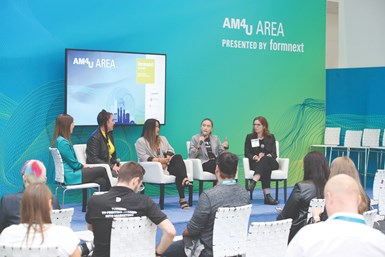Kingsbury Looks at Additive’s Journey Over the Last Decade
The ways people get into additive have changed along with the industry itself.
Alex Kingsbury (left) moderating a Women in 3D Printing panel at IMTS 2022 on “How We Support the Next Generation in 3D Printing.” Photo Credit: AMT
When asked about which past 3D printing projects she remembers most fondly, Alex Kingsbury starts listing body parts.
“A 3D printed sternum,” she says. “Another, a heel. A man was going to lose his leg because he had cancer in his heel bone, but we were able to 3D print a heel implant.”
Watching her at IMTS 2022 nonchalantly describing something that would’ve been inconceivable 20 years ago is a remarkable testament to the kind of innovation and invention that’s par for the course in AM. For the people these items are printed for (and implanted in), this technology is a literal lifesaver — a titanium miracle that enabled them to live longer than they would’ve without it. It was probably one of the biggest days of their lives. For Kingsbury, and many in AM, it was probably a weekday.
Like many (if not most) others, Kingsbury didn’t dream of working in AM. “It wasn’t necessarily intentional,” she says. “My pathway [to additive] was via engineering doing commercialization projects for a research institute and where I was immediately working with metals and metal powders.”
Now, more than a decade later, Kingsbury notes that the ways people get into additive have changed along with the industry itself. “I think a lot of people entering the industry these days are much more intentional about wanting to join,” she says. “There’s a lot more known about it.”
She counts herself lucky that she entered the field when she did. “I’m able to look back,” she says. “See where additive was, what it was doing, the status of it and the fact that it was so new.”
In 2013, she saw the industry’s commitment to adopting and commercializing AM, but at that point those big strides had yet to be made. Since that time, multilaser systems became industry standard, process monitoring is better understood and executed, and materials processing has been optimized. “I can look back and go ‘yeah, that really materialized.’ All those wish list items are now being delivered.”
Kingsbury notes that the hype for additive tends to come in waves — there was one in 2014, she says, and another in 2021 — a response to the innovation that was pent up during the pandemic. As far as where the industry goes from here, Kingsbury sees a future where additive is thought of as a regular, relied-upon part of the manufacturing repertoire.
“We want to see scale happening in additive,” she says. “More reliability and more trust as well.”
Hear more from Kingsbury in the new original IMTS+ show, Industry Roads, scheduled to be released in May 2023. IMTS.com/Watch.











